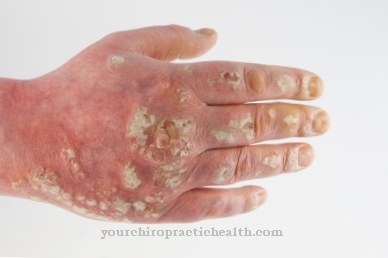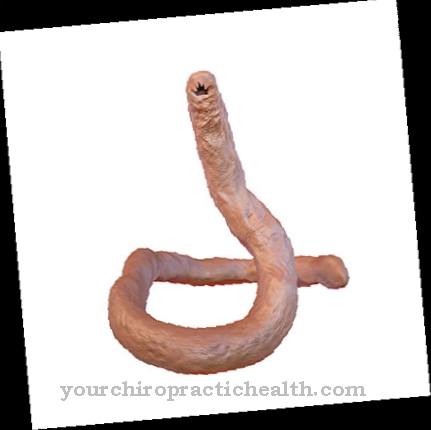A Food poisoning (food poisoning) is poisoning by food that appears inedible or toxic for the human digestion due to infections, bacteria, germs and pathogens, as well as heavy metals.
What is Food Poisoning?

A food or also Food poisoning is caused by ingestion of contaminated or poisoned food. Often the food has expired by its best before date or it is bacterially infected.
Various ailments can arise with food poisoning, which can lead to illness and death. Knowing what type of food poisoning is involved is therefore important in order to act quickly.
However, food poisoning must be differentiated from food allergy. Typical signs of food poisoning are usually stomach pain, nausea, vomiting and diarrhea. In any case, a doctor should be consulted to rule out complications.
causes
At a Food poisoning Metals such as zinc, copper, cadmium or lead often play a role. These poisons can be found in the enamelling or glaze of cooking utensils, for example. Often acidic foods dissolve these metals from pots and pans, which are then absorbed directly by the foodstuffs. When the food is consumed, food poisoning occurs as a result. The metals aluminum, chrome-nickel steel and nickel have been classified as harmless by official tests as triggers for food poisoning.
In addition to chemical poisons, there are also natural poisons that can cause food poisoning. These include poisons from fish, berries or mushrooms (see mushroom poisoning.
Bacterial food poisoning is the most common. The cause is a bacterial infection by germs and microorganisms. These bacteria are found primarily in milk and dairy products. Eggs, salads, soft ice cream and drinking water are also contaminated, especially in southern vacation areas (see Salmonella poisoning). The multiplication of germs is additionally promoted by warm temperatures. But even in our latitudes, a gap in the cold chain of food is enough to become infected with salmonella.
Contamination with the pathogen Clostridia, Shigella or bacilli are less often responsible for causing food poisoning. Deadly infections such as tuberculosis, cholera and anthrax can continue to be spread through decayed and infected food.
Symptoms, ailments & signs
In considering the symptoms of food poisoning, a distinction must be made between the two forms of such poisoning. The symptoms are different and that depends on whether the poison was ingested directly or an infection occurs through ingested bacteria. Still, there are a few symptoms that almost all forms of food poisoning have in common.
In most cases, this leads to severe nausea with vomiting.Abdominal cramps and severe pain are also common. Cramps in other parts of the body can occur. The stool usually turns into watery diarrhea, which is sometimes mixed with blood. The process can be acute or, with some delay, accompanied by fever. Most symptoms of acute food poisoning are very severe, but not particularly long-lasting.
The other symptoms depend on the toxins ingested. For example, some mushrooms or plants cause hallucinations, but have less of an effect on the gastrointestinal tract. The poison of the puffer fish leads to paralysis and can lead to respiratory arrest.
Food infections - i.e. infections caused by pathogens found in food - usually lead to symptoms that last for days. These are mostly concentrated in the gastrointestinal tract and lead to diarrhea and cramps. Nausea and vomiting can also occur for days.
Course of disease
A Food poisoning can occur a few minutes to a few hours after eating. Typical gastrointestinal symptoms usually occur.
Typical signs of food poisoning include diarrhea, vomiting, and abdominal cramps. A metabolic toxin, Clostridium botulinum, causes one of the worst food poisoning.
This bacterium causes classic food poisoning, which often comes about through infected meat or sausage. These botulinum toxins are among the most violent biological poisons.
They often lead to central respiratory paralysis and thus to death. An anti-toxic botulism serum must be taken immediately, which counteracts food poisoning.
Complications
Severe diarrhea and vomiting in the event of food poisoning result in a lack of fluids and electrolytes if the fluids that have been lost are not replaced by suitable drinks or infusions. The beginning of dehydration is indicated by drowsiness, dizziness and dry skin and mucous membranes. If left untreated, it can lead to cramps, kidney and circulatory failure.
Babies and the elderly are particularly at risk. As a sequela of bacterial food poisoning, joint inflammation, meningitis and inflammation of the inner lining of the heart (endocarditis) can occur. Depending on the pathogen, further complications are possible: an infection with Clostridium botulinum is often associated with visual disturbances, swallowing difficulties and paralysis, without treatment cardiac arrest and respiratory arrest can result.
Listeria are especially dangerous for immunocompromised people and pregnant women, they can lead to blood poisoning (sepsis) and cause miscarriages or stillbirths. Salmonella infections are usually uncomplicated, but in around five percent of all cases the pathogens enter the bloodstream and settle in internal organs or the skeletal system.
The result can be lung, kidney or liver abscesses as well as joint and bone inflammation. The bacterium Campylobacter jejuni is considered to be the cause of Guillain-Barré syndrome, in which sensory disorders occur due to inflammation of the nerve tract. Reiter's syndrome, characterized by inflammation of the joints, conjunctiva and urinary tract, is a rare complication of food poisoning.
When should you go to the doctor?
If food poisoning is suspected, a doctor should always be called in. This is especially necessary if the symptoms appear a few hours after eating raw fish or poultry. If other symptoms develop, such as fever or diarrhea, medical advice is required. If you have blood in your stool or have severe circulatory problems, go to the nearest hospital. Food poisoning can cause serious complications if not treated early. That is why the first symptoms must be clarified.
Consult your doctor at the latest after symptoms have persisted for one to two days. Infants should be taken to the doctor if diarrhea and / or vomiting persists for more than six hours. Small children must be examined by a doctor after 10 to 12 hours at the latest with persistent symptoms. Pregnant women and elderly or immunocompromised people must also be examined by a doctor if the symptoms mentioned occur. After recovery, another check-up should take place to ensure that the disease has been completely cured.
Treatment & Therapy
Just like the causes for one Food poisoning can be very diverse, so different therapies for the treatment of food poisoning must be adopted. In the event of symptoms such as diarrhea and vomiting, the fluid loss must first be compensated for. The therapy can be supported by the additional administration of antibiotics, if this is deemed necessary by the doctor.
In the case of butolism, on the other hand, an antitoxin must be given. Furthermore, the fight against shock belongs to the therapy of this food poisoning. In extreme cases, such as mushroom poisoning by the death cap, blood exchange may be necessary.
In order to prevent food poisoning, proper food hygiene and correct drinking water treatment are primarily important. Both of these can reduce food poisoning. In the case of milk, attention should be paid to pasteurized products. Correct food storage is also important. This includes uninterrupted cooling.
Another crucial factor in avoiding food poisoning is to pay attention to the best before date of food. Likewise, frozen and then thawed foods must not be refrozen.
In tropical countries like India, special attention must be paid to the hygiene of drinking water and food. The stomachs of European tourists are usually not used to the food in these countries. Even with good food, symptoms such as diarrhea can occur without food poisoning being the cause. Inquire about a preventive first-aid kit from your family doctor.
Outlook & forecast
Even if food poisoning is very uncomfortable for the affected patient, in most cases it proceeds without major complications. Especially if the disease only manifests itself through diarrhea and no further symptoms such as fever or bloody diarrhea, the chances of a cure are very good. The typical symptoms subside after just a few days.
The prognosis is of course better if the lack of fluids due to the diarrhea is compensated for with sufficient fluid intake. In order to avoid a possible electrolyte deficiency, children and the elderly in particular should drink a lot, otherwise an inpatient stay may be necessary.
If food poisoning can be assigned to the worse poisoning (for example botulism due to contaminated meat products), the prognosis is sometimes unfavorable. This is especially the case if the symptoms are not recognized early and treated accordingly. If there is no timely treatment for serious food poisoning such as botulism, the worst case scenario can be respiratory paralysis and death from the botulism pathogens within a period of three to six days. But even with early diagnosis and treatment, the mortality rate is still around ten percent.
Poisoning caused by the poison of a puffer fish has a mortality rate of about 60 percent. Salmonella poisoning, on the other hand, is more harmless, but this can lead to complications, especially in older people.
Aftercare
Food poisoning is a sometimes serious infection of the gastrointestinal tract with various pathogens. Depending on the type of germs, the severity of the illness and the duration of the food poisoning, the stomach and intestines are also affected a few weeks to months after the illness. This is why it is so important to have adequate aftercare, which focuses in particular on the selection of food, its preparation and compliance with hygienic standards.
In order to rebuild the affected intestinal flora after food poisoning, patients can, for example, take a cure with lactic acid bacteria. The doctor should always be consulted after a cured food poisoning, if pain in the stomach and intestines or other digestive complaints such as diarrhea and vomiting appear again.
As the immune system is weakened by food poisoning, the susceptibility to germs is increased and food poisoning can occur again more quickly. Those affected can also have a stool sample examined by the doctor for follow-up care, which can detect the presence of certain pathogens.
In general, follow-up care for food poisoning includes avoiding foods with a high germ content for at least a few weeks. For example, patients should avoid raw fish and raw meat. The doctor can also determine whether gastritis has developed after the food poisoning, which should be treated accordingly.
You can do that yourself
If food poisoning is suspected, a doctor should be consulted first. Some measures and home remedies help to cure the disease quickly.
First of all, it is advisable to drink enough - preferably still water or tea. The mineral balance is best balanced with electrolyte solutions from the pharmacy. Alternatively, you can use bananas, grated apples, broth or rusks. Probiotic yogurt can also be tried.
The food helps the body to form microorganisms and also regulates the intestinal tract. An effective home remedy is papaya juice, which is best drunk with seeds and several times a day. Or quite classic: warm milk with honey. Bed rest also applies. In the event of food poisoning, the body needs a lot of sleep and rest, because only then can it excrete the toxins quickly and without complications.
Various naturopathic remedies accelerate this process: the homeopathic preparation Eupatorium perfolatium, zinc or colloidal silver. Your own urine is also said to help with food poisoning. However, the use of these agents should always be done in consultation with the doctor. The doctor can give further tips to quickly cure food poisoning.


.jpg)
.jpg)























